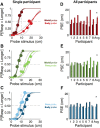Eye Movements in Darkness Modulate Self-Motion Perception
- PMID: 28144623
- PMCID: PMC5263893
- DOI: 10.1523/ENEURO.0211-16.2016
Eye Movements in Darkness Modulate Self-Motion Perception
Abstract
During self-motion, humans typically move the eyes to maintain fixation on the stationary environment around them. These eye movements could in principle be used to estimate self-motion, but their impact on perception is unknown. We had participants judge self-motion during different eye-movement conditions in the absence of full-field optic flow. In a two-alternative forced choice task, participants indicated whether the second of two successive passive lateral whole-body translations was longer or shorter than the first. This task was used in two experiments. In the first (n = 8), eye movements were constrained differently in the two translation intervals by presenting either a world-fixed or body-fixed fixation point or no fixation point at all (allowing free gaze). Results show that perceived translations were shorter with a body-fixed than a world-fixed fixation point. A linear model indicated that eye-movement signals received a weight of ∼25% for the self-motion percept. This model was independently validated in the trials without a fixation point (free gaze). In the second experiment (n = 10), gaze was free during both translation intervals. Results show that the translation with the larger eye-movement excursion was judged more often to be larger than chance, based on an oculomotor choice probability analysis. We conclude that eye-movement signals influence self-motion perception, even in the absence of visual stimulation.
Keywords: integration; oculomotor; perception; self-motion; vestibular.
Figures






References
-
- Benson A, Kass J, Vogel H (1986) European vestibular experiments on the Spacelab-1 mission: 4. Thresholds of perception of whole-body linear oscillation. Exp Brain Res 64:264–271. - PubMed
-
- Bremmer F, Klam F, Duhamel J-R, Ben Hamed S, Graf W (2002) Visual-vestibular interactive responses in the macaque ventral intraparietal area (VIP). Eur J Neurosci 16:1569–1586. - PubMed
-
- Britten KH, Newsome WT, Shadlen MN, Celebrini S, Moversushon JA (1996) A relationship between behavioral choice and the visual responses of neurons in macaque MT. Vis Neurosci 13:87–100. - PubMed
Publication types
MeSH terms
LinkOut - more resources
Full Text Sources
Other Literature Sources
